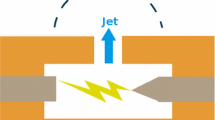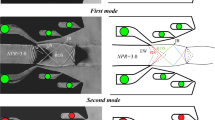Abstract
An experimental investigation was conducted to control the amplitude of shock unsteadiness associated with the interaction induced by a cylindrical protuberance on a flat plate in a Mach 2.18 flow. The control was applied in the form of an array of steady micro air-jets of different configurations with variation in pitch \((\beta )\) and skew angle \((\alpha )\) of the jets. The effect of air-jet supply pressure on control was also studied. Each of the micro-jet configurations was placed 20 boundary layer thicknesses upstream of the leading edge of the cylinder. The overall interaction is seen to get modified for all control configurations and shows a reduction in both separation- and bow-shock strengths and in triple-point height. A significant reduction in the peak rms value is also observed in the intermittent region of separation for each case. For \(90^{\circ }\) pitched jets placed in a zig-zag configuration, good control effectiveness is achieved at control pressures similar to the stagnation pressure of the freestream. At higher control pressures, however, their obstruction component increases and if these jets are not spaced sufficiently far apart, the effectiveness of their control begins to drop due to the beginning of spanwise jet-to-jet interaction. On the other hand, pitching or skewing the jets to \(45^{\circ }\) reduces the obstruction component considerably which at lower control pressures shows lower effectiveness. But at higher control pressure, the effectiveness of these configurations continues to increase unlike the \(90^{\circ }\) pitched jets.











Similar content being viewed by others
Abbreviations
- \(d\) :
-
= Diameter of the micro air-jet, mm
- \(D\) :
-
= Cylinder diameter, mm
- \(f_{\mathrm{s}}\) :
-
= Characteristic frequency of structures in incoming boundary layer, Hz
- \(G (f)\) :
-
= Power spectral density, kPa\(^{2}\)/Hz
- \(l\) :
-
= Spacing between the air-jets in a single unit, mm
- \(L\) :
-
= Length of the flat plate, mm
- \(M_{\mathrm{j}}\) :
-
= Sonic-jet exit Mach number
- \(M_{\infty }\) :
-
= Freestream Mach number
- \(P_{\mathrm{w}}\) :
-
= Mean wall pressure, kPa
- \(P_{\infty }\) :
-
= Freestream static pressure, kPa
- \(P_{0}\) :
-
= Tunnel stagnation pressure, kPa
- \(P_{\mathrm{oj}}\) :
-
= Air-jet stagnation pressure, kPa
- \(P_{\mathrm{j}}\) :
-
= Air-jet exit pressure, kPa
- \(q\) :
-
= Momentum flux ratio \((P\gamma M^{2})_{\mathrm{j}}/(P\gamma M^{2})_{\infty }\)
- \(\sigma _{\mathrm{w}}/P_{\mathrm{w}}\) :
-
= Non-dimensionalized local rms value
- \(\sigma _{\mathrm{max} }/P_{\mathrm{w}}\) :
-
= Non-dimensionalized peak rms value in the intermittent region of separation
- \(U_{\mathrm{e}}\) :
-
= External cross-flow velocity, \(\hbox {ms}^{-1}\)
- \(U_{\mathrm{j}}\) :
-
= Calculated equivalent jet exit velocity, \(\hbox {ms}^{-1}\)
- \(X\) :
-
= Co-ordinate in the streamwise direction
- \(Y\) :
-
= Co-ordinate in the transverse direction
- \(Z\) :
-
= Co-ordinate in the vertical direction
- \(\delta \) :
-
= Boundary layer thickness, mm
- \(\lambda \) :
-
= Distance between two air-jet units, mm
- \(\alpha \) :
-
= Skew angle of the air-jets, degrees
- \(\beta \) :
-
= Pitch angle of the air-jets, degrees
- \(\zeta \) :
-
= Control generated wave turning angle, degrees
- \(\theta \) :
-
= Compression ramp angle, degrees
References
Kistler, A.L.: Fluctuating wall pressure under separated supersonic flow. J. Acoust. Soc. Am. 36, 543–550 (March 1964)
Hadjadj, A., Dussauge, J.P.: Shock wave boundary layer interaction. Shock Waves 19, 449–452 (2009)
Dolling, D.S., Murphy, M.T.: Unsteadiness of the separation shock wave structure in a supersonic compression ramp flowfield. AIAA J. 21(12), 1628–1634 (1983)
Dolling, D.S.: Fifty years of shock-wave/boundary layer interaction research: what next? AIAA J. 39(8), 1517–1531 (2001)
Dolling, D.S., Or, C.T.: Unsteadiness of the shock wave structure in attached and separated compression ramp flows. Exp. Fluids 3, 24–32 (1985)
Muck, K.C., Andreopoulos, J., Dussuage, J.P.: Unsteady nature of shock-wave/boundary layer interactions. AIAA J. 26(2), 179–187 (1988)
Verma, S.B.: Experimental study of flow unsteadiness in a Mach 9 compression ramp interaction using a laser Schlieren system. Meas. Sci. Technol. J. 14, 989–997 (2003)
Dolling, D.S., Bogdonoff, S.M.: An experimental investigation of the unsteady behavior of blunt fin-induced shock wave turbulent boundary layer interaction. AIAA Paper 81-1287
Dolling, D.S., Brusniak, L.: Separation shock motion in fin, cylinder, and compression ramp-induced turbulent interactions. AIAA J. 27(6), 734–742 (1989)
Blinde, P.L., Humble, R.A., Oudheusden, B.W., Scarano, F.: Effects of micro-ramps on a shock wave/turbulent boundary layer interaction. Shock Waves 19, 507–520 (2009)
McCormick, D.C.: Shock/boundary layer interaction control with vortex generators and passive cavity. AIAA J. 31(1), 91–96 (1993)
Bur, R., Coponet, D., Carpels, Y.: Separation control by vortex generators devices in a transonic channel flow. Shock Waves 19, 521–530 (2009)
Babinsky, H., Makinson, N.J., Morgan, N.J.: Micro-vortex generator flow control for supersonic engine inlets. AIAA Paper 2007-0521
Szwabe, R.: Shock wave induced separation control by streamwise vortices. J. Therm. Sci. 14(3), 249–253 (2005)
Souverein, L.J., Debiève, J.-F.: Effect of air jet vortex generators on a shock wave boundary layer interaction. Exp. Fluids 49, 1053–1064 (2010)
Verma, S.B., Manisankar, C., Raju, C.: Control of shock unsteadiness in shock boundary layer interaction on a compression corner using mechanical vortex generators. Shock Waves 22(4), 327–339 (2012). doi:10.1007/s00193-012-0369-8
Lin, J.C.: Review of research on low-profile vortex generators to control boundary layer separation. Prog. Aerosp. Sci. 38(4–5), 389–420 (2002)
Khan, Z.U., Johnston, J.P.: On vortex generating jets, 2001. Int. J. Heat Fluid Flow 21, 506–511 (2000)
Kamotani, Y., Greber, I.: Experiments on a turbulent jet in cross-flow. AIAA J. 10(11), 1425–1429 (1972)
Zhuang, N., Alvi, F.S., Alkislar, B., Shih, C.: Supersonic cavity flows and their control. AIAA J. 44(9), 2118–2128 (2006)
Kumar, V., Alvi, F.S.: Toward understanding and optimizing separation control using micro-jets. AIAA J. 47(11), 2544–2557 (2009)
Verma, S.B., Manisankar, : Shock-wave boundary layer interaction control on a compression ramp using steady micro air-jets. AIAA J. 50(12), 2753–2764 (2012). doi:10.2514/1.J051577
Johari, H., McManus, K.: Visualization of pulsed vortex generator jets for active control of boundary layer separation. AIAA paper 97-2021
McManus, K., Magill, J.: Separation control in incompressible and compressible flows using pulsed jets. AIAA paper 96-1948
Vishwanath, P.R.: Shock-wave–turbulent-boundary layer interaction and its control: a survey of recent developments. Sadhana 12, 45–104 (1988)
Delery, J.M.: A physical introduction to control techniques applied to turbulent separated flows. AIAA paper 2000-2606
Babinsky, H., Ogawa, H.: SBLI control for wings and inlets. Shock Waves J. 18, 89–96 (2008). doi:10.1007/s00193-008-0149-7
Van Driest, E.R.: Turbulent boundary layer in compressible flows. J. Aeronaut. Sci. 18(3), 145 (1951)
Lin, C.C.: Turbulent flows and heat transfer (1959)
Stark, R.: Beitrag zum Verständnis der Strömungsablösung in Raketendüsen. Ph.D Thesis, Ins. für Aerodynamik and Gasdynamik, German, Univ. Stuttgart, Germany (2010)
Verma, S.B.: Shock unsteadiness in a thrust optimized parabolic nozzle. Shock Waves 19(3), 193–212 (2009). doi:10.1007/s00193-008-0180-8
Ali, M.Y., Alvi, F.S., Manisankar, C., Verma S.B., Venkatakrishnan, L.: Studies on the control of shock wave-boundary layer interaction using steady micro-actuators. In: 41st AIAA Fluid Dynamics Conference and Exhibit, AIAA paper 2011-3425
Dickmann, D.A., Lu, F.K.: Jet in supersonic crossflow on a flat plate. AIAA paper 2006-3451
Acknowledgments
The authors wish to thank the Aeronautical Research and Development Board (AR&DB) of India for supporting this project. The technical support of Mr. Ravi Dodamani during the model design and fabrication and of Mr. Perinaygam, Mr Janardhan and Mr. Narayanan, staff of the 0.3 m wind tunnel facility at NAL during the test campaigns, is gratefully acknowledged. Special thanks to Mr. Pardeep, Mr. Gangadhar, Mr. Shanmogan and Mr Charan Singh of NAL model shop for model fabrication.
Author information
Authors and Affiliations
Corresponding author
Additional information
Communicated by A. Hadjadj.
Rights and permissions
About this article
Cite this article
Verma, S.B., Manisankar, C. & Akshara, P. Control of shock-wave boundary layer interaction using steady micro-jets. Shock Waves 25, 535–543 (2015). https://doi.org/10.1007/s00193-014-0508-5
Received:
Revised:
Accepted:
Published:
Issue Date:
DOI: https://doi.org/10.1007/s00193-014-0508-5




